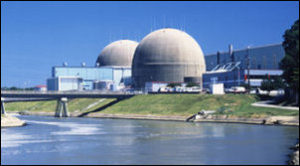
by Nelson Fegley
Climate change is real. Major climate fluctuations have occurred over hundreds of thousands of years, and the future will be similar. The changes are both anthropogenic (human caused) and due to natural causes. The magnitude of natural changes in temperatures and sea levels have far exceed those from anthropogenic causes. It is highly unlikely that we can significantly influence the natural causes, so whatever happens we will need to adapt to the resulting changes in temperature, sea levels, etc. More about this later.
The Commonwealth of Virginia, due to the structure the power industry, is well positioned to deal with both the anthropogenic and natural causes of climate change. About 87% of the state’s power is generated via nuclear and natural energy sources. Nuclear energy generation involves zero carbon emissions, while natural gas is clean relative to sources like coal. The combination of nuclear and natural gas provides dependable power, not dependent on the wind blowing and sun shining.
The capability to provide reliable generation of power is a key reason why Northern Virginia has become the world center for cloud computing and data storage centers. And businesses such as Amazon have committed an additional $35 billion for further expansion of this technology throughout Virginia. The economic fallout from these investments will help provide resources that will be needed to adapt to the changes in climate due to natural causes. An example would be funding major infrastructure projects in the Chesapeake Bay and Atlantic Coast areas.
The current political climate involves a goal of having power generation methods that produce zero carbon emissions. Wind and solar power are being pushed, but they are unlikely to become a major source of reliable power due to their intermittent nature. Storage battery technology is under development, but unlikely to provide the needed base load capacity. The wind projects that have been funded are also facing “headwinds” due to major unforeseen costs.
A realistic view of the future of carbonless power generation is an extended period (decades) where relatively clean natural gas is gradually phased out and eventually replaced by nuclear generation. The fact that the anthropogenic contribution to climate is small relative to the natural causes will eventually be recognized. This will result in investment of major resources and activity aimed at adapting to changes in climate. There will then be some clarity regarding the choice of a reasonable approach to the transition to use of nuclear for most of our power generation. The power-generation industry in Virginia is well positioned for a leading role in realizing this transition.
There are two major problems, however, involved in making this transition. First, whatever we accomplish is not going to make much difference if China and India are not on board. The carbon emissions from these countries far exceed those from the West. Changing this requires a long road of diplomacy, and the result is highly uncertain. The other issue is our rudimentary understanding of the science governing the natural causes of climate change. This limits our ability to predict the size of the natural contribution to climate change. We must instead rely on historical data. This data is convincing, but not well enough understood by the key political decision makers.
It is beyond the scope of this article to discuss the current understanding of the natural changes, but we should be aware of several major factors that are not part of the conventional wisdom. First, this is not an existential threat. The natural changes are primarily due to changes in the amount of energy received from the sun. These types of changes are to a large extent a result of variations in the motion of the earth around the sun. We are familiar with the changes due to the spin of the earth with a 24-hour period, and with the 365-day period of the orbit of the earth about the sun. We are also familiar with the periodic El Niño and La Niña episodes. We are less familiar with changes in the shape of the earth’s orbit around the sun and changes in the tilt angle of the spin of the earth (precession). The earth has a solid inner core surrounded by a molten mass. The solid core can shift to cause erratic movement of the earth. The sun occasionally has eruptions (sun spots), which when reaching the earth’s atmosphere interact with water vapor and change the amount of the sun’s energy that can penetrate.
A key takeaway is that these naturally caused variations in climate have been going on for many hundreds of thousands of years. The variations in temperature have often been far in excess of the 2 to 4 degrees C that we are currently concerned with in the drive to net zero emissions. An example is glacial periods, followed by relatively stable warming periods. We are now in an inter-glacial period, with relatively stable temperatures. About 15,000 years ago the northern U.S. and Europe were covered with half mile-plus thick ice sheets. And at that time the Earth had well more than 100,000 inhabitants who, even with a primitive existence, somehow managed to adapt to the changing climate. With modern technology available we certainly can also adapt. We will need to invest in adaptation to the changing conditions over the long run. The trillions of dollars we are spending on reducing carbon emissions will be much better spent helping the world to adapt to the changing conditions.
Nelson Fegley is a retired mechanical engineer who lives in Bumpass.

Leave a Reply
You must be logged in to post a comment.